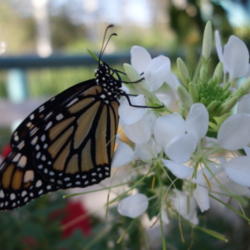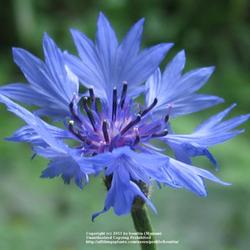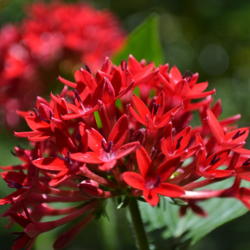
These annuals are easy to grow, look great in any garden, are easily found, and loved by pollinators of all kinds. Bees, birds, bugs, and butterflies all benefit from the list below. These beautiful flowers serve as host plants and/or as food for the pollinators.
Cleome- these tall annuals with a unique flower is a favored plant of bees, butterflies, and hummingbirds, Cleome provides nectar to many pollinators, as well as being a host plant to the Checkered White, Cabbage White and Great Southern White butterflies. They look beautiful as a border plant and when planted in mass.
Cosmos- Cosmos are found in nearly every cottage garden, for good reason. They grow easily in nearly every soil condition, they self-sow, they mix well with other plants and look good with everything, they make good cut flowers, they attract pollinators, and they handle neglect just fine. What's not to love? If you keep them deadheaded, the flowers will continue throughout the summer until frost.

Heliotrope- Dense clusters of flowers in shades of purple, blue and white, heliotrope is a fragrant annual that grows well in the ground or in containers. The purple varieties are more popular, and the white varieties are the most fragrant. This tropical was once a staple in cottage gardens, this sweetly scented flower is making a comeback. You will enjoy the fragrance and the delicate flowers just as much as watching the pollinators enjoy the nectar.
Nasturtium- Nasturtiums are sure to brighten up any corner of the garden. They thrive in poor soil, and the flowers are just as edible to humans as they are to pollinators. These cheerful plants bloom early in the season, giving our friend pollinators something to feast on early in the season. For those of us in the south, nasturtiums will wither away when the weather heats up, but it is easy to collect seeds for next year.
Nicotiana- the delicate trumpet-like flowers of nicotiana are just as fragrant as they are delicate. Bees, hummingbirds, and other pollinators will seek out these plants, and the humans will enjoy smelling the sweet scent as well. Nicotiana is not difficult to grow from seed, and is very quick growing. The heirloom varieties that most people think of when they think of Flowering Tobacco Plants are tall and must be started from seed, although there are newer varieties available which are more compact in size and can sometimes be found at garden centers.

Salvia- found in both our annual and perennial categories of pollinator-loving plants, salvias are loved by most pollinators. The annual varieties will happily reseed, but aren't difficult to control. Annual salvias look great when planted in groupings. The pollinators also enjoy their pollen and nectar sources to be grouped together so the plants are easily visible and accessible. Watch hummingbirds and bees zoom in to your patch of salvias.
Scabiosa, or pincushion flowers, are available both as annual and perennial varieties. Bees as well as butterflies are attracted to the flowers for their pollen and nectar. An easy flower to grow, sow your seeds in the early spring after danger of frost has passed. The plants will grow tall, often as tall as 36 inches, which will give you a great view of the pollinators enjoying this charming flower.
